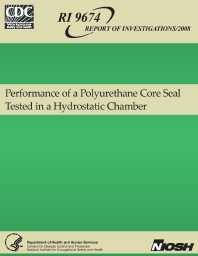Mining Publication: Performance of a Polyurethane Core Seal Tested in a Hydrostatic Chamber
Original creation date: May 2008
The Pittsburgh Research Laboratory of the National Institute for Occupational Safety and Health conducted a full-scale test of a composite polyurethane-aggregate seal in a hydrostatic chamber at the Lake Lynn Experimental Mine. This composite seal consisted of a polyurethane and limestone aggregate core that was formed between two concrete block walls. In the hydrostatic chamber test, water is used to pressurize the seal. During the test, the maximum average water pressure the seal was able to withstand was 18.9 psi. Further, the seal began to yield at an average water pressure of only 17 psi. At the time of the test, the minimum seal design requirement was 20 psi under 30 CFR 75.335 (2005). Therefore, based on this test, the seal did not meet the regulatory minimum design requirement. Uniaxial compressive tests conducted on samples from the polyurethane-aggregate core revealed that both the compressive strength and the elastic modulus of the material were much less than that for polyurethane only with a density of 10.0-12.0 lb/ft3. The significant reduction in the strength and stiffness of the polyurethane-aggregate mixture results from the formation of a soft polyurethane foam around each piece of aggregate. The formation of the soft foam seems to be caused by residual moisture from the aggregate. The moisture also caused the density of the polyurethane in the polyurethane-aggregate mixture to be less than the design requirements. The lower density of the polyurethane in the mixture, along with the formation of zones of pure polyurethane only, resulted in the overall seal density being less than the design requirements. During seal construction, steps were taken to control the moisture, but were not successful. An analysis of the seal failure showed that the calculated shear stresses at failure and the estimated shear strength of the polyurethane-aggregate mixture are fairly close. This suggests that the strength properties of the polyurethane-aggregate mixture along with a weak zone of poorly bonded aggregate controlled the maximum pressure the seal could withstand. At the time of the seal testing, the minimum design requirement was 20 psi, as specified at 30 CFR 75.335 (2005). New emergency temporary standards for seal designs were promulgated on May 22, 2007, with a minimum requirement of 50 psi under specified conditions. However, it will be shown that the evaluation of the polyurethane seal performance as designed to meet the older 20-psi criterion can be relevant to the design requirements under the new standards.
Authors: DR Dolinar, MJ Sapko, SP Harteis
Report of Investigations - May 2008
NIOSHTIC2 Number: 20033877
Pittsburgh, PA: U.S. Department of Health and Human Services, Public Health Service, Centers for Disease Control and Prevention, National Institute for Occupational Safety and Health, DHHS (NIOSH) Publication No. 2008-129, Report of Investigations 9674, 2008 May; :1-38
See Also
- Clearing the Air
- Comparison of Methods: Dynamic Versus Hydrostatic Testing of Mine Ventilation Seals
- Explosion Pressure Design Criteria for New Seals in U.S. Coal Mines
- Inflatable Partitions for High-Expansion Foam Generators
- NIOSH Mining Update - New Publications 1995-96
- Passive Mine Blast Attenuators Constructed of Rock Rubble for Protecting Ventilation Seals
- Performance of a Light-scattering Dust Monitor in Underground Mines
- Progress Toward Improved Engineering of Seals and Sealed Areas of Coal Mines
- Strength Characteristics and Air-Leakage Determinations for Alternative Mine Seal Designs
- Strengthening Existing 20-psi Mine Ventilation Seals With Carbon Fiber-Reinforced Polymer Reinforcement
- Content source: National Institute for Occupational Safety and Health, Mining Program


 ShareCompartir
ShareCompartir
